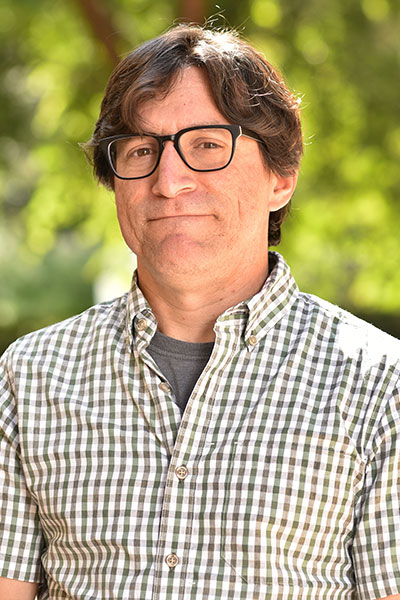Anthony Friscia
Associate Teaching Professor
Director of the UCLA Cluster Program

Office: 329 Hershey Hall
Phone: (310) 206-6011
Biography
Born and raised in Chicago, I attended Washington University in St. Louis, where I majored in Anthropology and Physics. After going on my first paleontological dig the summer (in Utah) after graduation, I attended Kent State University and received an M.A. in Anthropology. While there I got to do field work in Pakistan looking for fossil whales. I came to UCLA in 1998 as a Ph.D. student in Ecology & Evolutionary Biology under Dr. Blaire Van Valkenburgh, and received my degree in 2005. While a graduate student, I began teaching the summer anatomy dissection course for IBP and TAing in the UCLA Cluster Program. After graduation I spent a couple of years as a “freeway” professor, before carving out a position at UCLA where I teach most of the undergraduate human anatomy courses for IBP and in the Cluster Program. I am currently also the Director of the UCLA Cluster Program, and work with our faculty, TAs, and campus partners to create this valuable experience for incoming UCLA freshmen.
Research Interests
I am primary primarily a mammalian paleontologist who studies Paleogene and early Neogene carnivores as well as primates, bats, and birds. I work on functional morphology of teeth and skulls and how they relate to macroevolutionary trends. My field work is primarily in North America (Utah and southern California) and Sub-Saharan Africa (Kenya). I also research modern mammal functional ecology and community structure, including urban mammal communities in Los Angeles. I also work on topics of science pedagogy, especially how experiential education can enhance understanding and retention in biological sciences.
Education
B.A., Anthropology/Physics, Washington State University in St. Louis 1994
M.A., Anthropology, Kent State University 1998
Ph.D., Biology, University of California, Los Angeles 2005
Selected Publications
Gunnell, G.F., D.M. Boyer, A.R. Friscia, S. Heritage, F.K. Manthi, E.R. Miller, H.M. Sallam, N.B. Simmons, N.J. Stevens, E.R. Seiffert, “Fossil lemurs from Egypt and Kenya reveal an African origin for Madagascar’s aye-aye”, Nature Communications, 9 : 3193- (2018) .
Friscia, A.R, “The Origin of Higher Taxa: Palaeobiological, Developmental, and Ecological Perspectives”, Quarterly Review of Biology, 92 : 189- (2017) .
Brown, C., E. Curd, A. Friscia., “An Actualistic Experiment to Determine Skeletonization and Disarticulation in the La Brea Tar Seeps”, Palaios, 32 : 119-124 (2017) .
Murphey, P.C., Townsend, K.E.B., Friscia, A.R., Westgate, J., Evanoff, E., Gunnell, G.F., “Paleontology and stratigraphy of middle Eocene rock units in the southern Green River and Uinta Basins, Wyoming and Utah”, Geology of the Intermountain West, 3 : 1-53 (2017) .
A. Friscia and R. Dunn., “Uintan creodonts from the Uinta Basin, with a description of the post-cranial skeleton of Oxyaenodon”, Journal of Vertebrate Paleontology, (2016) .
Bodony, D., L. Day, A. Friscia, L. Fusani, A. Kharon, G. Swenson, M. Wikelski, B. Schlinger., ” Determination of the Wingsnap Sonation Mechanism of the Golden-Collared Manakin (Manacus vitellinus)”, Journal of Experimental Biology, 219 : 1524-1534 (2016) .
A.R. Friscia, G.D. Sanin, W.R. Lindsay, L.B. Day, B.A. Schlinger, J. Tan, M.J. Fuxjager, “Adaptive evolution of a derived radius morphology in manakins (Aves, Pipridae) to support acrobatic display behavior”, Journal of Morphology, 277 : 766-775 (2016) .
A. Friscia, “Ecological Trends and Replacement in the Carnivorous Mammals of Africa across the Paleogene/Neogene Boundary”, Journal of Vertebrate Paleontology, (2015) .
A. Friscia and C. Brown, “An actualistic experiment to examine skeletonization and disarticulation in the La Brea tar seeps”, Journal of Vertebrate Paleontology, (2014) .
G. Slater and A. Friscia., “Where should we expect to find early bursts of trait evolution? A case study using Carnivora”, Journal of Vertebrate Paleontology, (2013) .

612 Charles E. Young Drive East
Box 957246
Los Angeles, CA 90095-7246
(t) (310) 825-4373
(f) (310) 206-9184

